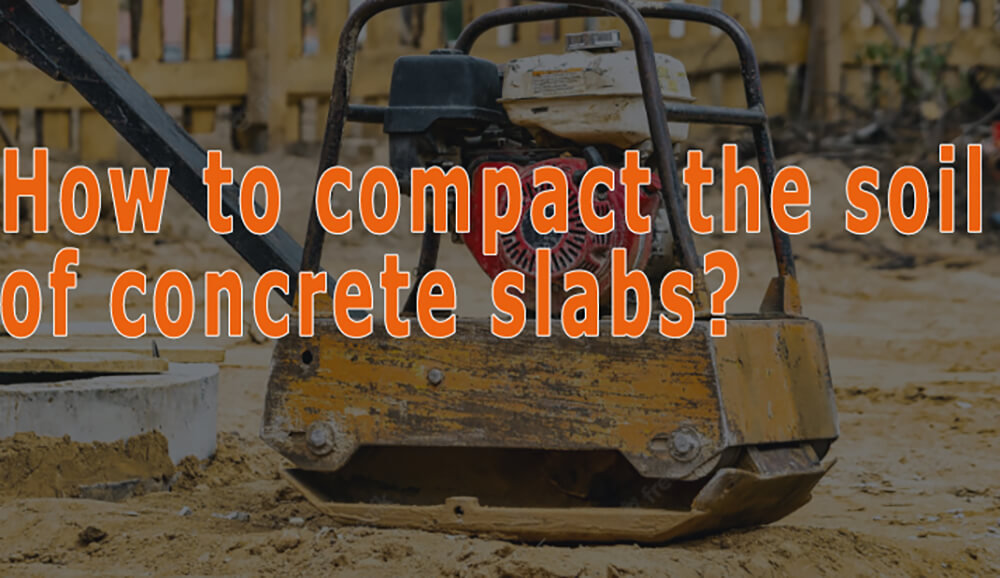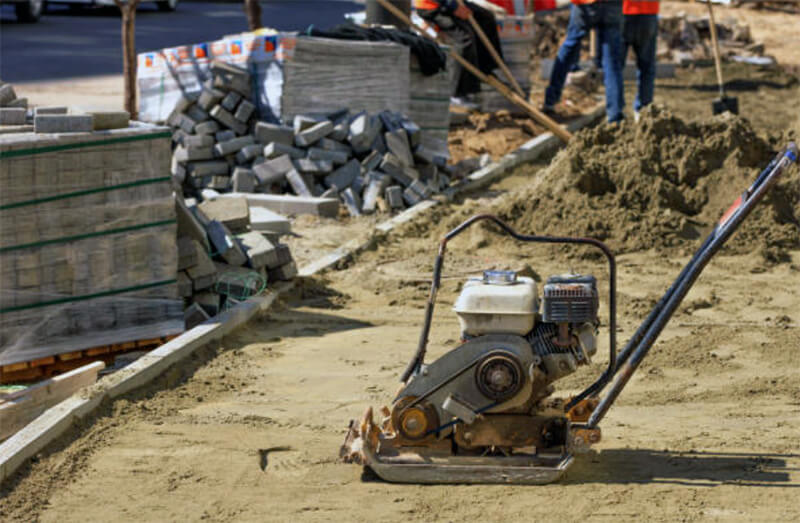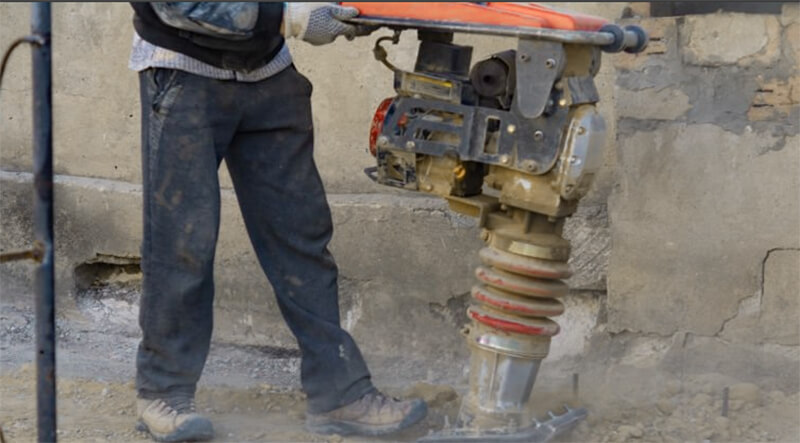16Sep 2023
table of contents

Preparing the ground for a concrete slab is critical to ensuring a long life for the concrete slab itself. One crucial step is compacting the soil. How to compact soil for concrete slabs?
The main purpose of soil compaction is to remove excess air and water from the soil. When the soil is loose and contains air, it settles easily, causing the concrete slab to be uneven and unstable. By compacting the soil, these voids are eliminated, creating a denser and more stable foundation, minimizing settlement and increasing load-bearing capacity.
To compact the soil in preparation for concrete slabs, a mechanical compactor should be used. A plate compactor is the most common tool used to compact soil for concrete slabs. For small areas, a hand tamper may do the trick, but a mechanical compactor is better. Sturdy metal plates and powerful force compact the soil better, making them more effective and efficient for larger projects.
Tight compaction helps squeeze out water and air, binding solid soil particles tightly together. This provides a dense and strong foundation for the concrete slab.
Large areas of flooring can be compacted using a mechanical compactor before cement is applied. For smaller areas, such as no larger than a section of concrete sidewalk, you can use hand tamping. Anything larger than this is best compacted using mechanical tamping to improve efficiency and quality.
A manual tamper has a flat metal base and a heavy bar, usually with two handles on each side. This allows you to push down on the main pole or handle, compacting the soil to form concrete. When using a hand tamper to compact the ground, you should lift it to waist height, take a step, and then lower the slab to the ground. Apply as much power as possible, making sure each strike overlaps the last strike.
A mechanical tamping machine has an ignition engine and a thick plate underneath the engine. Mechanical tampers are also known as plate tampers. The plate is the part of the machine that touches the ground when it is running. Operators often walk behind, pushing the machine to compact soil on small surfaces that are difficult for the roller to reach.
To compact gravel, a pneumatic roller or plate compactor are the best tools. Pneumatic rollers have a platform fixed on two axles. The rear axle has an extra wheel than the front axle. This type of machine compacts soil well in smooth and less steep areas. Pneumatic rollers compact cohesive or non-cohesive soils including sand, gravel, silt and sandy clay.
You can choose to use a pneumatic roller to compact gravel, but the more popular option is a plate compactor. One of the best soil compactors for gravel is forward plate compactor.

When you compact soil or gravel, moisten the ground before you start compacting. Moisture helps achieve better compaction because the particles slide and stick together more easily. If the soil or gravel lacks moisture, it will take more effort to compact it. On the other hand, when compacting gravel, excess moisture can weaken the foundation. Therefore, it is important to only wet the gravel before compacting it and preparing the concrete slab.
Some other things to consider when compacting gravel and soil include:
The compactor's vibrating plates feature one-way motion and a centrifugal force range of 3,000 to 5,000 pounds, which is best suited for interlocking gravel.
The frequency of force exerted by the plate on the surface. Higher frequencies are ideal when using small aggregates in interlocking paver projects.
The compactor should achieve a lift or depth of 6 inches on small gravel or sand to provide adequate force.
You can use a variety of tools to compact soil for a concrete slab, including vibratory tampers, rollers etc.
A vibratory tamper is a compactor with a base plate that is spring activated and driven by a small power or motor. They weigh between 60 and 100 kg and are ideal for restricted areas. They compact all types of soil to create concrete slabs.
Rammer presses are lightweight machines that are usually operated by one person. Rammers work well for compacting cohesive soils, such as clay in ditches or building foundations.
Vibratory plate compactors are typically used on coarse soils such as sand containing 3-7% fine clay particles. Vibratory plate compactors are available in weight ranges from 60kg to 1 ton and use vibration to compact larger areas.

Smooth wheel rollers statically compress the soil beneath the roller. There are single drum or two drum tractors with each drum weighing 10kg and 180kg. These machines compact granular soil for road or highway construction.
The degree of compaction achieved by a compactor, usually 1 inch of soil that the machine can compact for every 1,000 pounds of compaction force. It’s important to make sure you have the right equipment to compact the area and material you need. A properly sized compactor will have enough power to prevent pressure or moisture from creating cracks that can lead to uneven surfaces.
When choosing a plate compactor, it's important to take into account the force needed to compact both the soil and the specific material you are working with. The force rating of a plate compactor is measured in pounds and indicates the amount of force required to create an indentation in the plate. The compactor's force rating and vibration force can be found in the machine's manual.
Centrifugal force, on the other hand, measures the vibrating force of the machine, which means gravel with more force will penetrate deeper into the soil.
To compact soil manually, you can use a handheld tamping machine with a heavy-duty base to gradually compact the soil. Make sure you have prepared the soil by applying adequate moisture and removing harmful debris.
You can also compact the soil with water instead of using a compactor. Please follow this procedure:
Remove debris from the soil and spread it smoothly using a bow rake or broom rake.
Spray a light mist of water or slowly drip water until a pool of water begins to form on the surface. Low-pressure or drip irrigation systems are recommended for their ability to efficiently deliver water directly to the soil.
Please let the water settle after an hour.
To properly water the soil, continue watering until water accumulates on the surface, then allow it to drain. Repeat this procedure until the soil becomes compact, ensuring that water does not quickly drain into it.
If you want better compaction, use a hand tamper or walk on moist soil.
You can use a sledgehammer instead of a plate compactor for tamping. You can lift it up and drop it on the surface repeatedly. Using a hammer is tedious, but it can work if you don't have a plate compactor available. Alternatively, you can use an impact compactor, trench roller, or tamper.
Above we have listed a range of different machines that can be used to compact soil. You can choose from any of them. But if you don’t have access to these machines, you may need to return to traditional hand tamping methods.
Like gravel, sand also needs to be compacted; however, this can be a challenging task. Since sand is porous, moisture and water can easily get into it. Sand crumbles easily after compaction because it lacks bonding strength.
Before compacting sand, its moisture content should be assessed. If the voids in the sand are dry or filled with water, there won't be any force holding the particles together.
You apply vibrating forces to relatively moist sand to create configurations. The best way to compact sand is to mix it with other clayey soil or gravel; otherwise, it may cause future disintegration.
Both BISON plate compactor and tamping rammer offer reliable options for soil compaction. They have their distinct advantages and are suitable for different soil types and project sizes. By choosing the right tool for the job, you can ensure the proper preparation of the ground for concrete slabs.
If you're looking for a high-quality plate compactor or tamping rammer, consider checking out BISON's range of products. Their expertise in manufacturing these machines makes them a reputable choice in the industry.
inquiry form here
BISON BLOG, All the latest news and views from Bison Machinery.